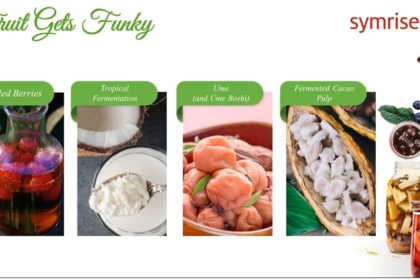
Fermentation was the No. 2 trend on the North America Flavor Trend Report for 2020, but with a twist: sweet foods are the new star of fermentation. The trend report was released by Symrise, an international producer of flavors and fragrances.
“Over the past few years, we’ve seen fermentation has really come to dominate the condiment category with foods like kimchi, that have really led the charge,” says Julia Gorman, Symrise digital marketing specialist. Now, “fruit is getting funky.”
Pickling berries, fermenting tropical fruits, using sour fruits and incorporating pulp byproduct into fermented dishes are some of the key flavor trends among chefs. Adds Dylan Thompson, Symrise marketing and consumer insights manager: “It’s all about the evolution of fermentation.”
Fermentation was particularly high on the list because of gut health components. Fermentation encompasses some of the mega trends Symrise is seeing this year. Consumers are buying simple foods that benefit a healthy lifestyle. Fermentation’s “health benefits remain a huge bonus,” Gorman says.
Symrise polled chefs and mixologists for their survey, and found four fermented fruit flavor trends:
- Pickled Berries. Made popular through the cookbook “Noma’s Guide to Fermentation,” Scandinavian cuisine is making a major impact on America’s acceptance of fermented fruit.
- Tropical Fermentation. Mixologists have been particularly experimenting with tropical fruits in drinks. Fermented pineapple, for example, is used to “add flavor funk to what is otherwise a classic beach cocktail,” Gorman adds.
- Ume (and Ume Boshi). More chefs are using Ume, the salty, sour Japanese plum. It can be pickled, brined or traditionally served with rice.
- Fermented Cacao Pulp. Usually a wasted byproduct of cacao bean production, the pulp has an array of health benefits. Chefs are salvaging the pulp to use in a variety of dishes.
